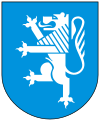Locarno District facts for kids
Quick facts for kids
Locarno District
Distretto di Locarno
|
|||
|---|---|---|---|
|
District
|
|||
|
|||
| Country | |||
| Canton | |||
| Capital | Locarno | ||
| Area | |||
| • Total | 591.67 km2 (228.45 sq mi) | ||
| Population
(2020)
|
|||
| • Total | 63,774 | ||
| • Density | 107.7864/km2 (279.166/sq mi) | ||
| Time zone | UTC+1 (CET) | ||
| • Summer (DST) | UTC+2 (CEST) | ||
| Municipalities | 23 | ||
The Locarno District (also called Locarnese) is a special area in Canton Ticino, Switzerland. It's like a county or region within the canton. As of 31 December 2020, about 63,774 people live here.
Contents
Geography of Locarno District
The Locarno District covers an area of about 551 square kilometers (213 square miles). This is how the land is used:
- About 6.4% of the land is used for farming. This includes growing crops and areas for animals to graze.
- A large part, about 58.1%, is covered by forests. Many trees grow here!
- Around 4.9% of the land has buildings and roads. This is where people live and move around.
- About 2.3% of the district is covered by rivers or lakes. These are important water sources.
- The remaining 24.3% is land that isn't used for farming or building. This might be very rocky or have special plants.
People of Locarno District
The Locarno District is home to many people. As of December 2020, there are about 63,774 residents.
Languages Spoken
In 2000, most people in the district spoke Italian (43,408 people). Other languages spoken include German (8,831 people), French (971 people), and Romansh (83 people). Some people also spoke other languages.
Population Changes
In 2008, there were more women (52.5%) than men (47.5%) living in the district. The population includes both Swiss citizens and people from other countries.
The number of people living in the district changes over time. In 2008, more babies were born than people died. Also, more people moved into the district than moved away. This caused the population to grow by about 1.1% that year.
Age Groups
Here's how the population was divided by age in 2009:
- Children (0-9 years old): 8.2%
- Teenagers (10-19 years old): 9.6%
- Young adults (20-29 years old): 10.0%
- Adults (30-39 years old): 12.5%
- Adults (40-49 years old): 16.6%
- Adults (50-59 years old): 13.6%
- Seniors (60-69 years old): 13.4%
- Seniors (70-79 years old): 9.8%
- Seniors (over 80 years old): 6.5%
Homes and Buildings
In 2000, there were over 65,000 buildings in the district.
- About 45.4% were single-family homes.
- Around 12.3% were two-family buildings.
- About 32.2% were multi-family buildings (like apartment blocks).
- Some buildings (about 6,613) were used for both living and business.
There were also many apartments. Most apartments had three rooms. About 60% of apartments were lived in all year, while others were used only during certain seasons.
Historical Population
The number of people living in the Locarno District has changed a lot over the years:
| year | population |
|---|---|
| 1850 | 22,362 |
| 1880 | 24,361 |
| 1900 | 24,594 |
| 1950 | 33,218 |
| 1980 | 50,778 |
| 1990 | 52,286 |
| 2000 | 57,327 |
Politics and Elections
In Switzerland, people vote for their leaders and important decisions. This is called an election.
Federal Elections
In the 2007 federal election, people in Locarno District voted for national leaders. The most popular political party was the FDP, getting about 30.3% of the votes. Other popular parties included the CVP and the SP. About 42.5% of eligible voters participated in this election.
Local Elections
In 2007, there were also elections for the local government, called the Ticino Gran Consiglio. More than half of the registered voters (55.5%) cast their ballots. The PLRT was the most popular party in this election.
Religion
According to the 2000 census, most people in the Locarno District are Roman Catholic (about 71.8%). About 10.9% belong to the Swiss Reformed Church. Some people belong to other churches, and a small number did not state their religion.
Education
In 2009, there were 9,332 students in the Locarno District. The education system in Ticino helps students learn from a young age all the way to college or a job.
Early Education
- Kindergarten: Children can attend non-mandatory kindergarten for up to three years. In 2009, 1,319 children were in kindergarten.
- Primary School: This program lasts for five years. There are standard schools and special schools for students who need extra support.
Secondary Education
- Lower Secondary School: After primary school, students can choose different paths. Some go to a two-year middle school, then a two-year program to prepare for a job. Others go to a four-year program to get ready for higher education.
- Upper Secondary School: This level prepares students for a trade (like a specific job skill) or for university. Students can learn while doing an internship or apprenticeship, or study full-time.
Professional Programs
There are also professional programs that last three years. These programs train students for jobs in fields like engineering, nursing, computer science, business, and tourism.
Circles and Municipalities
The Locarno District is divided into smaller areas called "circles," and each circle contains several "municipalities" (like towns or small cities). Here are some of them:
| Circolo di Locarno | ||||
|---|---|---|---|---|
| Flag | Coat of arms | Municipality | Population (31 December 2020) |
Area km² |
| Locarno | 15,728 | 19.27 | ||
| Muralto | 2,604 | 0.60 | ||
| Orselina | 706 | 1.94 | ||
| Total |
19,038 |
21.81 | ||
| Circolo delle Isole | ||||
|---|---|---|---|---|
| Flag | Coat of arms | Municipality | Population (31 December 2020) |
Area km² |
| Ascona | 5,554 | 4.97 | ||
| Brissago | 1,685 | 17.79 | ||
| Ronco sopra Ascona | 550 | 5.02 | ||
| Losone | 6,647 | 9.53 | ||
| Total |
14,436 |
37.31 | ||
| Circolo di Onsernone | ||||
|---|---|---|---|---|
| Flag | Coat of arms | Municipality | Population (31 December 2020) |
Area km² |
| Onsernone | 663 | 29.86 | ||
| Total |
663 |
29.86 | ||
| Circolo del Gambarogno | ||||
|---|---|---|---|---|
| Flag | Coat of arms | Municipality | Population (31 December 2020) |
Area km² |
| Gambarogno | 5,163 | 51.8 | ||
| Total |
5,163 |
51.8 | ||
| Circolo della Melezza | ||||
|---|---|---|---|---|
| Flag | Coat of arms | Municipality | Population (31 December 2020) |
Area km² |
| Centovalli | 1,135 | 51.1 | ||
| Terre di Pedemonte | 2,627 | 11.59 | ||
| Total |
3,701 |
62.47 | ||
| Circolo della Verzasca | ||||
|---|---|---|---|---|
| Flag | Coat of arms | Municipality | Population (31 December 2020) |
Area km² |
| Lavertezzo | 1,245 | 58.11 | ||
| Verzasca | 799 | c. 143 | ||
| Cugnasco-Gerra | 2,780 | 35.72 | ||
| Total |
4,665 |
237.24 | ||
| Circolo della Navegna | ||||
|---|---|---|---|---|
| Flag | Coat of arms | Municipality | Population (31 December 2020) |
Area km² |
| Tenero-Contra | 3,201 | 3.69 | ||
| Minusio | 7,356 | 5.85 | ||
| Mergoscia | 201 | 12.14 | ||
| Brione sopra Minusio | 480 | 3.84 | ||
| Gordola | 4,650 | 7.04 | ||
| Total |
15,888 |
32.56 | ||
Changes to Municipalities
Over the years, some municipalities in the Locarno District have joined together to form new, larger ones. This helps with local government and services.
- On October 25, 2009, Borgnone, Intragna, and Palagnedra became one municipality called Centovalli.
- On April 25, 2010, Gambarogno was formed by combining nine smaller municipalities.
- On April 14, 2013, Cavigliano, Tegna, and Verscio merged to create Terre di Pedemonte.
- On April 10, 2016, Gresso, Isorno, Mosogno, and Vergeletto joined to form the new municipality of Onsernone.
- On October 18, 2020, several municipalities like Brione/Verzasca, Corippo, Frasco, Sonogno, and Vogorno merged into the new municipality of Verzasca. Some land from Lavertezzo and Cugnasco-Gerra also became part of Verzasca on this date.
Villages
- Gordemo
See also
 In Spanish: Distrito de Locarno para niños
In Spanish: Distrito de Locarno para niños



